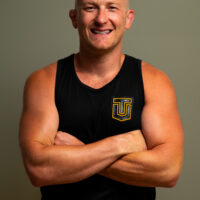Matt Lafleur, who lives in Louisiana, was diagnosed with Friedreich’s ataxia (FA) in 1994 at age 9. He teams up with Coach Damon to demonstrate an adaptive pushup focused on control, strength, and joint stabilization.
Disclaimer: The information in this video is for educational and informational purposes only and should not be considered a substitute for professional medical advice. Always consult your doctor or other trained medical professional before beginning any new exercise program to ensure it is safe and appropriate for you.
Transcript
What’s up, guys? Coach Damon with my boy Matt here. We’re going to show you guys another rare moves exercise. This one is a classic pushup.
Now, there’s tons of variations of pushups. We’re going to show you guys a pushup to the knees. If you want to up it and go to the toes — if you don’t have a whole lot of ankle flexion — you can even add something under here where you can get the full pushup.
But let’s watch Matt do the pushup. Hand positioning is very important here. I want the hands back. If his hands are up here in his ears, we’re putting a lot of unnecessary strain on the shoulder. So we need the hands back. Joint angles — good. About 90-degree angles.
If I have some help, I’m just going to go one on the hip, one on the shoulder. I’m not helping him — I’m just supporting him, stabilization-wise.
“Ready. Elbow tight — and go. Woo woo! Locked out. Arms, core is engaged, triceps, chest. Back down — slow. Nice work, Matt.”
You see, a lot of times for our rare disease athletes, the negative is harder.
“So push back up. Here you go. Nice.” So from here, I want to make sure my arms are locked, core is engaged. I don’t just want to throw my elbows out because that’s how we lose it. We want to go slow.
We unlock the elbows — yes, exactly like that. We want to catch. We want to focus on control through the whole range of motion.
“Good job, Matt. Nice work, man.”













